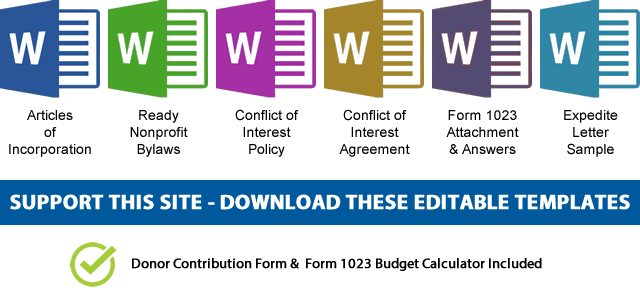Removing Toxic Board Members: A Step-by-Step Guide That Won’t Get You Sued

Some board members start out as saints; passionate, helpful, exactly what your nonprofit needs. Then something shifts. They go from engaged to toxic. They hijack meetings, bulldoze conversations, undermine leadership, ghost their responsibilities, or start treating your nonprofit’s mission like a stepping stone to their own agenda.
This isn’t just annoying. It’s a full blown governance crisis. And if you don’t handle it properly, you’re not just risking hurt feelings; you’re inviting legal messes, donor distrust, and a slow-motion car crash that could take your whole organization down.
When that moment comes, you’ve got two choices:
Handle it fast, clean, and by the book, or let your nonprofit spiral into dysfunction, lawsuits, and maybe even an IRS audit.
Red Flags: You’ve Got a Problem Board Member in your nonprofit When…
Here’s what it actually looks like in the wild:
- They ghost three board meetings in a row, then suddenly show up demanding a vote on their pet project like nothing happened.
- They bypass the Executive Director, email staff directly, and CC donors on their “suggestions” like they run the place.
- They weaponize the bylaws every time they don’t get their way, but if you quizzed them on the actual text, they’d flunk.
- They treat the nonprofit bank account like their personal expense fund, conveniently “forgetting” to reimburse or file receipts.
- They bring their pastor, business partner, or cousin to board meetings and expect them to sit in like it’s a casual family gathering.
- They’re still “technically” a board member, but haven’t lifted a finger in a year and still want to cast votes on major decisions.
- They claim to “speak for the board” to the media or public without actually consulting the board.
Bottom line: If someone is creating more drama than value, and they’ve become a threat to the mission, morale, or basic board of directors function, then it’s time to stop hoping they’ll fix themselves. It’s time to act.
Step One: Read Your Bylaws
You can’t remove a board member because they’re annoying. You have to follow due process set in your nonprofit bylaws. Skip it, and you’ll have more problems than you started with, including a lawsuit, a revoked tax exemption, or a complaint to your state attorney general.
Here’s what you’re looking for:
- Do the bylaws allow for removal? Some say yes with a vote and some are silent, which is a governance failure on its own.
- What’s the required vote threshold? Majority? Super majority? Unanimous consent? Don’t guess, verify.
- Do you have to give notice? Most states require notice and a chance to respond. That’s basic due process.
- Are terms clearly defined? If you never set term limits or renewal procedures, you’re stuck until they quit or die.
Important: If your bylaws don’t say anything about removal, state law takes over – and some states make it ridiculously hard. That’s why your bylaws should always have a clear and legally sound removal clause. If it doesn’t, fix it now!
How to Remove a Board Member (the Grown-Up Way)
Document Everything Like You’re Building a Court Case
You’re not firing someone on vibes. You need dates, incidents, absences, votes, conflicts of interest, receipts (as in proof, not literal receipts – unless that’s part of the problem). The messier it’s been, the tighter your paper trail needs to be.
Example: “Board member failed to attend five of the last six meetings, publicly berated the ED at the October meeting, and attempted to approve a personal contract without disclosure.”
Offer a Quiet Exit First
Most people don’t want to be publicly booted. A private conversation like “This clearly isn’t working. We’d prefer a resignation.” can save everyone time and dignity. Some will go quietly. Others will double down. Be prepared for both.
Example: “We’ll accept a resignation letter by Friday. Otherwise, the board will proceed with formal removal per Article IV, Section 6 of the bylaws.”
Follow the Bylaws Exactly
Not sorta. Not “close enough.” Follow every step to the letter; notice period, vote format, quorum rules. If it says 10 days written notice, don’t do it in 7 days. If it says two thirds of seated members, don’t count an abstention. One misstep and they could sue.
Hold the Vote and Record It Like a Court Transcript
Do it in a properly called board meeting. Use exact wording, state the motion, hold the vote, record who voted what, and of course save the board meeting minutes. You’re creating the official record that proves this wasn’t personal, it was process. And make it fast and efficient. You’re basically firing someone, so don’t drag it out. Rip off the Band-Aid and move on.
Cut Off Access Immediately
Change all the passwords, revoke file access, and remove their name from public listings. If they had signing authority or access to financials, notify your bank in writing like yesterday. Do not assume they’ll leave things alone out of goodwill.
What NOT to Do (Unless You Want a Lawsuit)
- Don’t gossip, back channel, or form secret text groups.
- Don’t vote via email or chat, it won’t hold up.
- Don’t forget to notify your state, and the IRS if they held an officer role.
- Don’t leave them in the loop just to be “nice.” Toxic board members rarely leave quietly if they still have access.
When the Problem Is the Founder
Buckle up. Nonprofit Founders are the hardest to remove – not legally – but emotionally. They often built the organization from scratch, so people feel loyal. But when a founder becomes a threat to the mission, whether by burnout, control freak behavior, or ego – they need to go like anyone else.
- Document it like any other board member.
- Prepare for pushback. This can blow up fast. Expect threats, donor confusion, and maybe a public tantrum.
- Lean on the mission. “This is about the future of the organization, not one person.”
And yes, your bylaws better not have any stupid clauses giving the founders special privileges. If they do, fix that too.
Final Word: Protect the Mission, Not the Drama
Removing a board member feels personal, but it’s not. It’s nonprofit governance. It’s your job.
If someone’s presence is doing real harm to your mission, your staff, your community, or your credibility; you don’t owe them endless chances – this is governance, not group therapy. You DO owe your organization a functioning board.
So go ahead and remove that toxic board member – but move decisively and follow procedure. Then move on and get back to the work that actually matters.
 NOTE: If you’d like to receive the following organizing documents:
NOTE: If you’d like to receive the following organizing documents:- Nonprofit Articles of Incorporation,
- Nonprofit Bylaws,
- Nonprofit Conflict of Interest Policy,
- Conflict of Interest Policy Acknowledgment,
- Form 1023 Attachment with all the answers,
- Form 1023 Expedite Letter template,
- and Donor Contribution Form
in Microsoft Word Document format, please consider making a donation and you’ll get to download them immediately. Not only they're worth well over $1000 in value, they will save you weeks of copy pasting and formatting as they are ready to go templates which only need changing names and addresses.

